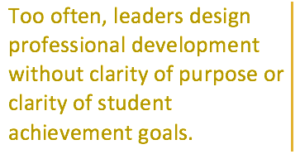Teacher Moving is Only the First Step
 This is the time of year when leaders make their most important decisions. When it comes down to it, there are two critical factors that will determine the student achievement results for the upcoming year—teachers and teaching.
This is the time of year when leaders make their most important decisions. When it comes down to it, there are two critical factors that will determine the student achievement results for the upcoming year—teachers and teaching.
No doubt, school administrators are spending considerable time thinking about teacher “moving”: retaining their most effective teachers, replacing teachers who won’t be returning, and reassigning teachers so that they may become more effective.
 Administrators know that if they are able to replace a less skillful teacher with a more skillful one, they upgrade the instruction in their school. Conversely, they know that if they replace a skillful teacher with a less skillful one, the overall quality of instruction decreases.
Administrators know that if they are able to replace a less skillful teacher with a more skillful one, they upgrade the instruction in their school. Conversely, they know that if they replace a skillful teacher with a less skillful one, the overall quality of instruction decreases.
Great attention is also being paid to placing teachers on the right teams in hopes that they will find the right “chemistry” that will allow them to work together in a highly collaborative manner.
Strengthening Teaching is the Critical Step
However, improving instruction through personnel changes and reorganization of staff is limited. The most effective school administrators understand that the real power is in strengthening the teaching in their schools.
Strengthening instruction within a school is challenging as it must ultimately result in changing the behavior of teachers both inside  and outside the classroom. And, for a variety of reasons, behavior change is the most challenging of all as it requires us to learn new skills as opposed to relying on our habits.
and outside the classroom. And, for a variety of reasons, behavior change is the most challenging of all as it requires us to learn new skills as opposed to relying on our habits.
Most leaders focus on improving instruction by offering teachers various professional development opportunities during the summer and throughout the school year. Many will focus on specific instructional techniques that teachers will be asked to practice in isolation. This is a failed model that only works for a very small percentage of teachers. Unfortunately, it often contributes to many teachers’ distaste for professional development.
As opposed to focusing first on instructional techniques, effective leaders begin with helping teacher teams establish clear student achievement goals. They help teachers understand that the goals  are the end and teaching is the means to that end. Too often, leaders design professional development without clarity of purpose or clarity of student achievement goals.
are the end and teaching is the means to that end. Too often, leaders design professional development without clarity of purpose or clarity of student achievement goals.
Effective leaders also help teacher teams create core values that, together with their performance goals, will guide their individual and collective behaviors as they strive to strengthen their instruction. These leaders establish opportunities for teachers to learn and practice new behaviors as well as receive the reinforcing and shaping feedback that encourages them to grow.
Compared to focusing on teachers, strengthening teaching is hard. It’s not about teachers nor about professional development of isolated instructional techniques. It is about leaders who have the skill to clarify the student achievement goals that are most  important to the school and to establish a safe, nurturing and collaborative culture that encourages the behavior change that is necessary for schools to be successful.
important to the school and to establish a safe, nurturing and collaborative culture that encourages the behavior change that is necessary for schools to be successful.
During this most important season that includes some of the most important decisions that a school leader makes, ensure that you are focusing on teachers, teaching and…leadership.
For additional information, please visit Mark’s webpage.
Click here if you would like to sign up to receive future articles via email. Thank you.
 Mark Rolewski has assisted schools and school districts in designing and implementing successful turnaround initiatives for over 19 years. Mark has assisted with school turnaround in many districts and schools including those in Florida, New York City, Hartford, New Orleans, Memphis, Kansas City and Los Angeles. He is widely sought after by schools and school districts to speak about and assist with turnaround initiatives.
Mark Rolewski has assisted schools and school districts in designing and implementing successful turnaround initiatives for over 19 years. Mark has assisted with school turnaround in many districts and schools including those in Florida, New York City, Hartford, New Orleans, Memphis, Kansas City and Los Angeles. He is widely sought after by schools and school districts to speak about and assist with turnaround initiatives.